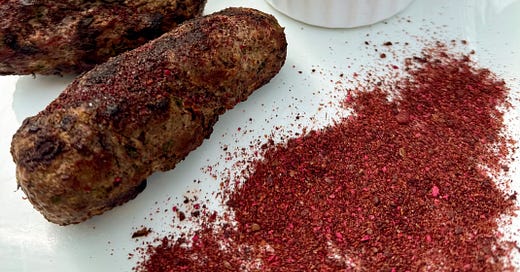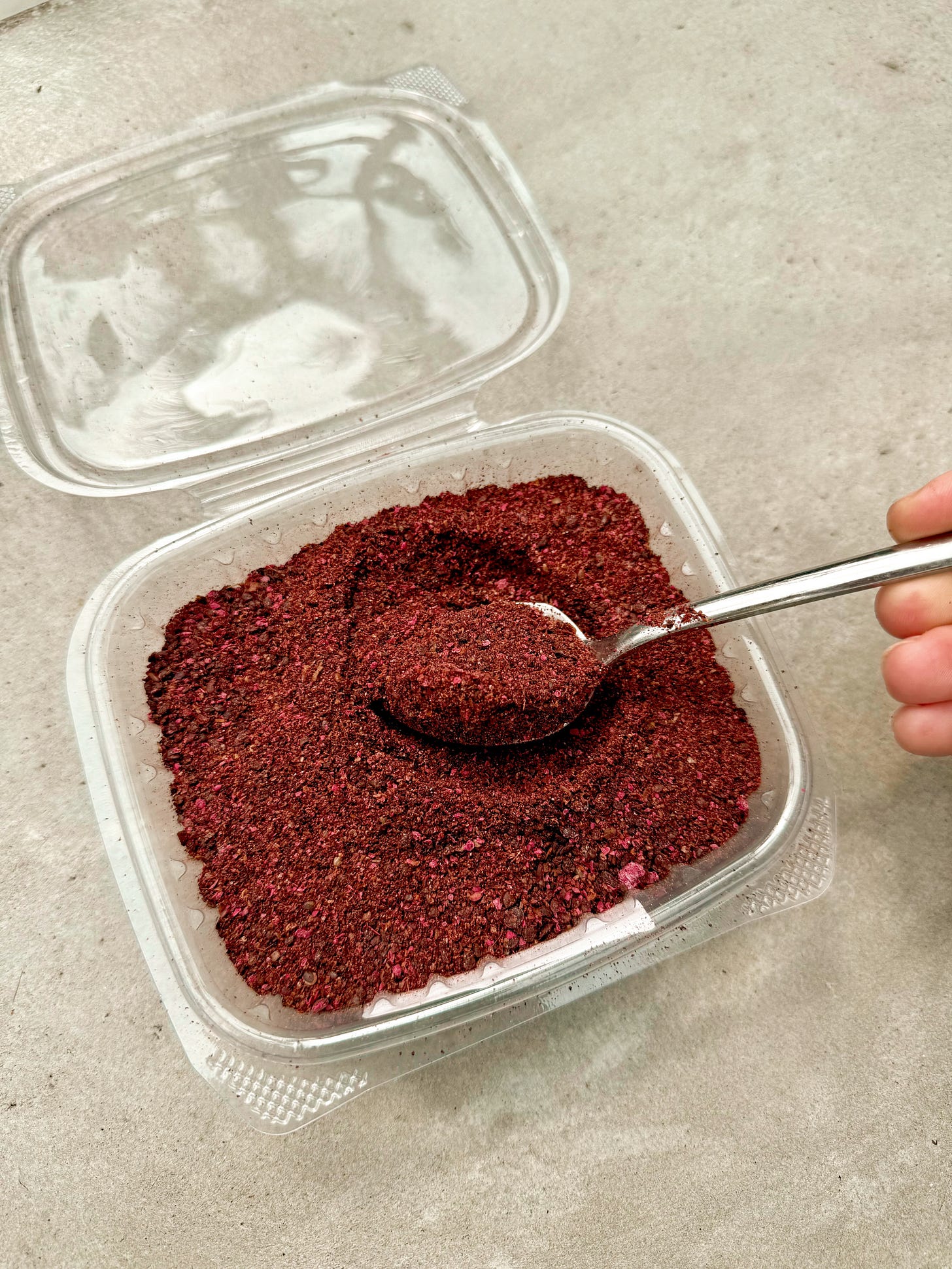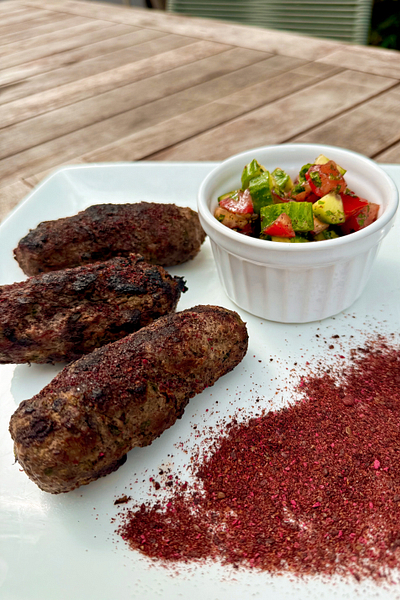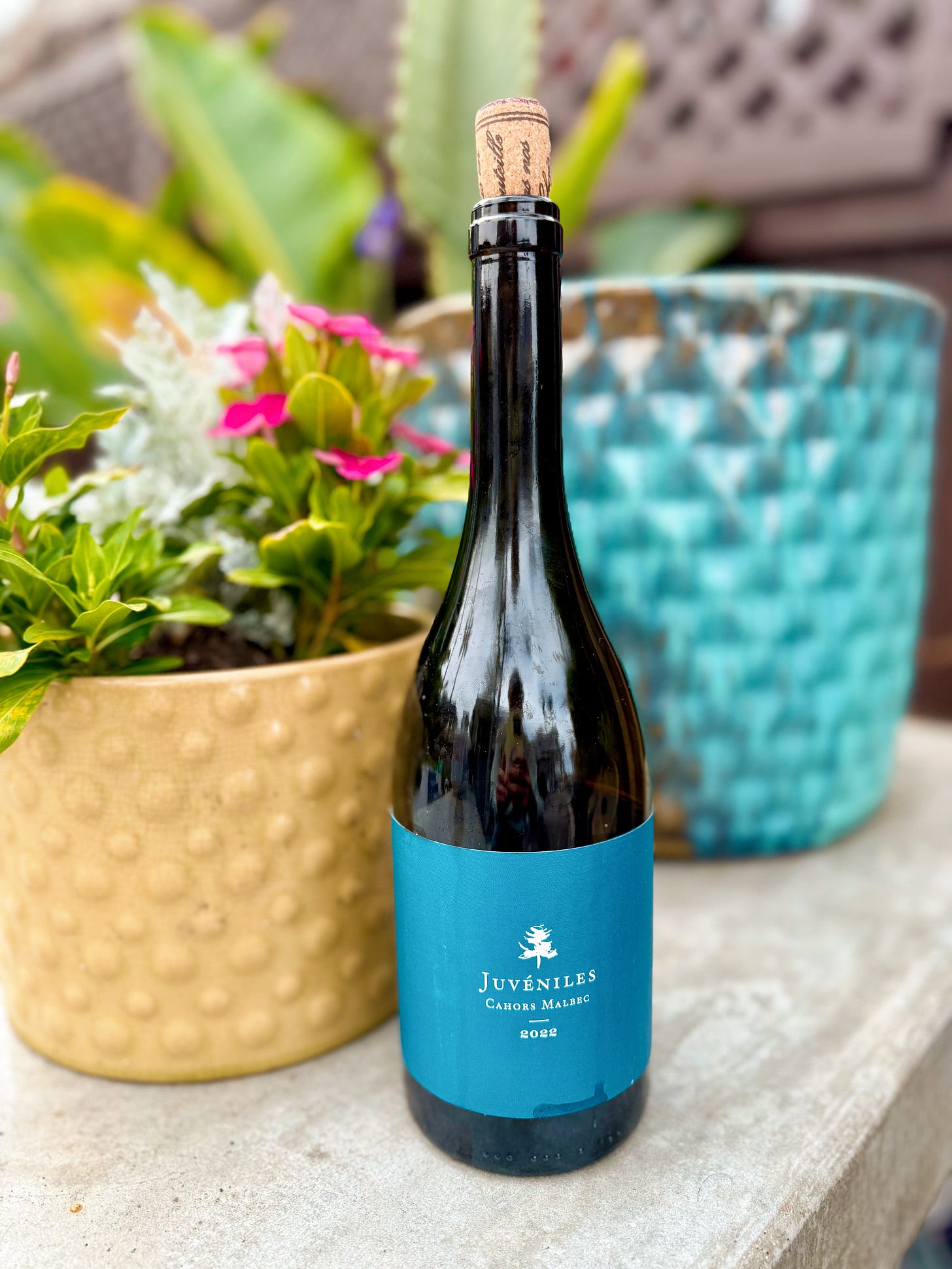Can I Get You Something to Eat?
Chaldean Beef Kabobs with Sumac + Spice Exchange + Summer Malbec
I rang the bell, prepared to leave the box of wine for my friend, Serena, on the doorstep of her home. I knew she wasn’t there, but just in case someone was, I waited a beat. As I turned on my heels the door cracked. A grandmotherly figure with curly brown hair stuck her head out, eyes narrowed. My friend’s parents had just been visiting so I ventured a guess. “You must be Serena’s mom.” The older woman scrutinized me for a long second, trying to determine, perhaps, if I was someone she should know. “I’m dropping off this wine for Serena. We haven’t met yet. I’m Amy.”
Her face relaxed and her hands came off the doorknob, flying up into the air. “You are the one who wanted the sumac and za’atar!” Yes, that was me. “Come in, come in.”
Until then, I hadn’t noticed the tall, gray-haired gentleman hovering in the hall, also curious about who was at the door. As I was pulled inside my friend’s mother announced to her husband. “This is the one who wanted the spices!” His face lit up as bright as hers. “Ah yes! You are the one. Come in, come in.” As they ushered me into my friend’s kitchen, they asked me a question I had been prepared for ever since Serena started telling me stories of her Iraqi immigrant parents. “Can we get you something to eat? Are you hungry?”
Serena’s parents came to the United States as part of a late 20th century exodus of Chaldeans, a Catholic practicing ethnic group of Assyrian descent who faced persecution as a religious minority in Iraq. Her family settled in Michigan where a community of Chaldeans took root beginning in the early 20th century, attracted to the Detroit area because of the economic opportunities surrounding the auto industry. Today, an estimated 187,000 Chaldeans live in the Detroit metro area, and with this group comes a rich food heritage blending Mesopotamian roots with the foodways of neighboring Middle Eastern countries.
Though it is not what brought my friend to San Diego, approximately 50,000 Chaldeans live in this region, the majority residing in the east county community of El Cajon. It is to El Cajon that Serena’s parents pilgrimage when they visit to stock up on spices – sumac and za’atar as well as a particular seven spice blend of redolent of cloves, cinnamon, nutmeg and pepper that is ground to order at the Najat Spice Store.
As they told me about the store and retrieved my containers of spices, I was peppered with questions. They talked as long married couples sometimes do - at the same time, breaking in to amend, correct and add to the other’s advice.
How are you using the sumac? - Kabobs. - You are making kabobs, right? - That is the best way for sumac. But don’t put it in the meat! - Too bitter. You put it on the meat, after you cook. - Ground beef, lean. - Only 10% fat! - Minced onion, bunch of parsley. - Just the leaves! - Pepper, just a little salt. - What kind of skewer do you have for the kabobs? Not those wooden skewers, you need the metal ones. - Flat metal. Let me show you. Here you go. - If you don’t have this, you go to the Lebanese market and ask for it. It’s the only way for kabobs. - And salad. - You are making Fattoush? No? Okay you do a little salad with parsley, onion, tomato and sumac, that’s all. - With the kabobs.
I opened the plastic carton of the crimson sumac and inhaled its floral, citrusy aroma. Serena’s mother grabbed my arm. “You keep this in the refrigerator, or else it will go bad.” That was a new one to me, but instantly made sense. Sumac is a spice made of the dried up, ground fruit of the sumac bush. It is neither seed, like a peppercorn, nor bark, like cinnamon. I could understand how the delicate aromatics of this dried fruit would last longer in cold storage.
Thirty minutes, and a lot of cooking advice later, I climbed back in my car, the scent of spices filling the small space. My phone rang. It was Serena. She had seen me on their Ring device and wanted to make sure all was okay. More than okay, I told her, I finally got to meet her parents!
“How much food did they give you?”
They had offered meat pies which I reluctantly turned down, as we would be leaving town in a few days and were working through leftovers. “Only spices. But they promised to take me with them to the spice shop next time. And even better than meat pies, they gave me recipes.”
I hope Serena’s parents will forgive me for tweaking their kabob recipe ever so slightly. Making the recipe at home I grated the onion, rather than mincing, as I find that, when grilling, the onion better integrates into ground meat. Also, having had a particularly wet kabob on one occasion, I now drain the grated onion for five minutes to siphon off the excess moisture. On one occasion I did find 90% lean grass-fed beef, and it was delicious. On another occasion at the market, I was staring between 85% and 93% and settled on a pound of each. Combined it had a nice fat content, still lean but with a good mouthfeel. “Little salt” is surely a matter of taste but for 2 lb. of meat you are going to want more than a sprinkle. I’ve settled on ¾ tsp. of fine sea salt, a bit less than most recipes would suggest for ground beef but with the onion and parsley plus the sumac at the end, there is enough other seasoning to lift the flavors while keeping the salt light. If you aren’t sure, try frying a small amount of the seasoned meat before forming the kebabs to check if the salt is to your preference. Finally, if you have time, mix the meat then chill it in the refrigerator for an hour – it will be easier to form into torpedoes and if you aren’t able to run to the Lebanese market and buy the authentic variety of kabob skewer, chilled, the meat will still cling to your skinny metal skewer without falling apart on the grill.
Where to Find…
If you are in the San Diego area, visit the Good Old Days Spice (also known as Najat Spice Store) in El Cajon where half a pound of exceptionally fresh sumac will set you back $3.50.
Recipe…
Chaldean Beef Kabobs with Sumac
Sumac is available in the spice section of most markets these days. In the past I have had good success with NY Shuk, available at Sprouts as well as on Amazon. And do keep it in the refrigerator, it will keep the aromatics longer.
Serves 8
Time: 40 minutes active time plus 1 hr. chilling (optional)
2 lb. lean ground beef, 90% fat or 1 lb. each of 85% and 93% fat
¾ tsp. sea salt
¼ tsp. black pepper
1 large onion
1 bunch parsley, leaves only
Vegetable oil
3 T. sumac
In a medium bowl, mix ground beef with salt and pepper until thoroughly combined. Place in the refrigerator to keep cold while prepping the onions and parsley.
Peel onion and grate on a box grater. Transfer to mesh strainer or colander set over a small bowl and let excess liquid drain for five minutes. You should have about ¾ cup of onion.
Clean and dry parsley leaves. Finely chop. You should have about 1 cup.
Mix seasoned ground beef with onion and parsley until thoroughly integrated. If you have time, place the mixture back in the refrigerator for an hour to get cold - it will make forming the kabobs easier.
When ready to eat, preheat a grill to medium high. Lightly oil a baking sheet and have 8 metal skewers ready for threading. Remove beef mixture from the fridge. Grab a tennis ball sized quantity into one hand. Roll between your palms for 30 seconds or so until the mixture adheres into a cohesive ball. (Note: if the mixture is very sticky, you can wet your hands with water to help at this point.) Once in a ball, begin to roll it into a torpedo shape about 5 inches in length. Thread this onto a metal skewer and place on the oiled baking sheet. Repeat with the remaining meat and skewers. Lightly brush formed kabobs with oil.
When grill is hot, brush the grill grate well with oil. Place kabobs on the grill. Rotate every few minutes to cook evenly on each side. When cooked through, transfer kabobs to a platter and dust liberally with sumac. Serve with a simple tomato and parsley salad, tzatziki or other yogurt sauce, and warmed pita or flatbread of your choice.
Looking for other grilling recipes?
Gochujang Sweet and Spicy Chicken
Fig and Roasted (or Grilled) Radicchio Salad with Arugula and Blue Cheese
To Drink…
Chateau du Cedre Juvéniles Malbec, Cahors, France 2022
It’s barbecue season and that usually has me reaching for Syrah or Malbec for the combination of juicy dark fruit and meaty, smoky undertones with enough tannin to stand up to fatty meat, hot off the grill. However, in this case, I wanted to hold back on the tannins so that they didn’t overpower the delicate aroma of the sumac.
Enter the Chateau du Cedre Juvéniles Malbec 2022 from Cahors in Southwest France. As the name suggests, the wine is made from younger vines grown organically in the sandy-clay soils of the Lot Valley. Traditionally known as a “black wine”, Malbec, or Côt as it is called locally, is usually a tightly wound, tannic beast that requires years of aging before the fruit reveals itself. This wine is an exception. Bright plum, cherry and raspberry marry soft, supple tannins, a gentle companion to the tart aromatics of sumac dusted kabobs. With only minimal sulfur for stability this is a wine unlikely to leave you with a headache if you are sensitive to additives. And at only 12.5% ABV, this red is easy to reach for you when you have unexpected guests drop by and you ask, “Are you hungry? Can I get you something to eat?”
To learn more about Malbec from France, read my Halloween special, “The Black Wine of Lot”.
And if sulfites still confuse you, read my primer here.
From $20. Available at Caves in Encinitas or online at Wine.com or various retailers.








